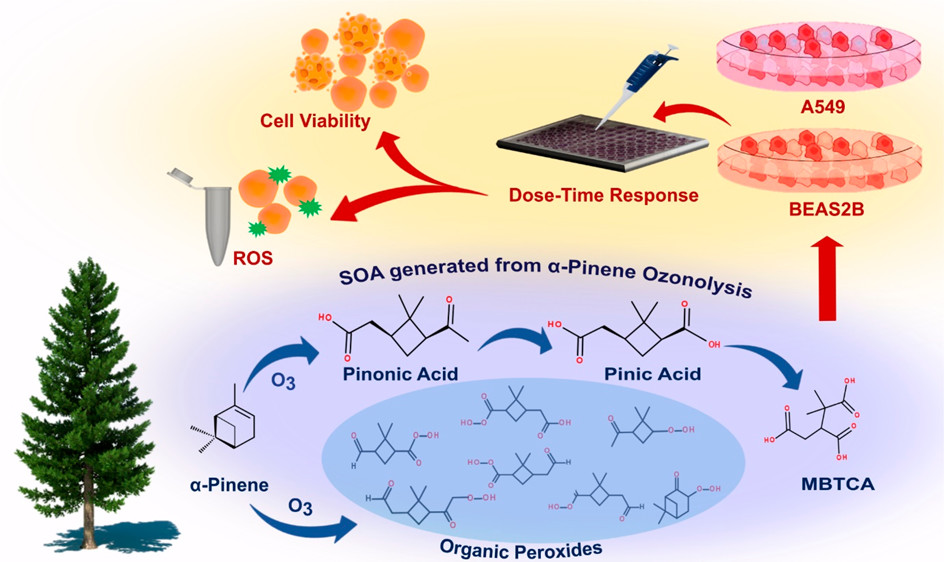Toxicological Responses of α-Pinene-Derived Secondary Organic Aerosol and Its Molecular Tracers in Human Lung Cell Lines
Faria Khan, Karina Kwapiszewska, Yue Zhang, Yuzhi Chen, Andrew T. Lambe, Agata Kołodziejczyk, Nasir Jalal, Krzysztof Rudzinski, Alicia Martínez-Romero, Rebecca C. Fry, Jason D. Surratt, and Rafal Szmigielski
Chem. Res. Toxicol. 2021, 34, 3, 817–832
Abstract
 Secondary organic aerosol (SOA) is a major component of airborne fine particulate matter (PM2.5) that contributes to adverse human health effects upon inhalation. Atmospheric ozonolysis of α-pinene, an abundantly emitted monoterpene from terrestrial vegetation, leads to significant global SOA formation; however, its impact on pulmonary pathophysiology remains uncertain. In this study, we quantified an increasing concentration response of three well-established α-pinene SOA tracers (pinic, pinonic, and 3-methyl-1,2,3-butanetricarboxylic acids) and a full mixture of α-pinene SOA in A549 (alveolar epithelial carcinoma) and BEAS-2B (bronchial epithelial normal) lung cell lines. The three aforementioned tracers contributed ∼57% of the α-pinene SOA mass under our experimental conditions. Cellular proliferation, cell viability, and oxidative stress were assessed as toxicological end points. The three α-pinene SOA molecular tracers had insignificant responses in both cell types when compared with the α-pinene SOA (up to 200 μg mL–1). BEAS-2B cells exposed to 200 μg mL–1 of α-pinene SOA decreased cellular proliferation to ∼70% and 44% at 24- and 48-h post exposure, respectively; no changes in A549 cells were observed. The inhibitory concentration-50 (IC50) in BEAS-2B cells was found to be 912 and 230 μg mL–1 at 24 and 48 h, respectively. An approximate 4-fold increase in cellular oxidative stress was observed in BEAS-2B cells when compared with untreated cells, suggesting that reactive oxygen species (ROS) buildup resulted in the downstream cytotoxicity following 24 h of exposure to α-pinene SOA. Organic hydroperoxides that were identified in the α-pinene SOA samples likely contributed to the ROS and cytotoxicity. This study identifies the potential components of α-pinene SOA that likely modulate the oxidative stress response within lung cells and highlights the need to carry out chronic exposure studies on α-pinene SOA to elucidate its long-term inhalation exposure effects.
Secondary organic aerosol (SOA) is a major component of airborne fine particulate matter (PM2.5) that contributes to adverse human health effects upon inhalation. Atmospheric ozonolysis of α-pinene, an abundantly emitted monoterpene from terrestrial vegetation, leads to significant global SOA formation; however, its impact on pulmonary pathophysiology remains uncertain. In this study, we quantified an increasing concentration response of three well-established α-pinene SOA tracers (pinic, pinonic, and 3-methyl-1,2,3-butanetricarboxylic acids) and a full mixture of α-pinene SOA in A549 (alveolar epithelial carcinoma) and BEAS-2B (bronchial epithelial normal) lung cell lines. The three aforementioned tracers contributed ∼57% of the α-pinene SOA mass under our experimental conditions. Cellular proliferation, cell viability, and oxidative stress were assessed as toxicological end points. The three α-pinene SOA molecular tracers had insignificant responses in both cell types when compared with the α-pinene SOA (up to 200 μg mL–1). BEAS-2B cells exposed to 200 μg mL–1 of α-pinene SOA decreased cellular proliferation to ∼70% and 44% at 24- and 48-h post exposure, respectively; no changes in A549 cells were observed. The inhibitory concentration-50 (IC50) in BEAS-2B cells was found to be 912 and 230 μg mL–1 at 24 and 48 h, respectively. An approximate 4-fold increase in cellular oxidative stress was observed in BEAS-2B cells when compared with untreated cells, suggesting that reactive oxygen species (ROS) buildup resulted in the downstream cytotoxicity following 24 h of exposure to α-pinene SOA. Organic hydroperoxides that were identified in the α-pinene SOA samples likely contributed to the ROS and cytotoxicity. This study identifies the potential components of α-pinene SOA that likely modulate the oxidative stress response within lung cells and highlights the need to carry out chronic exposure studies on α-pinene SOA to elucidate its long-term inhalation exposure effects.



